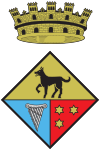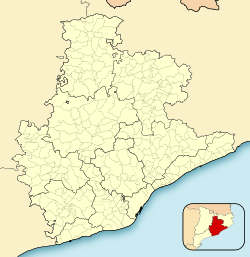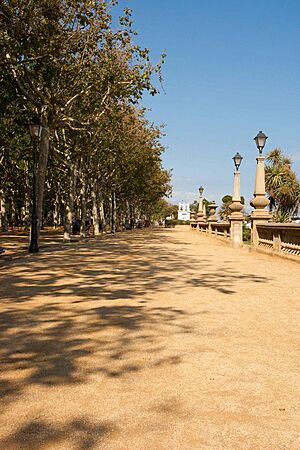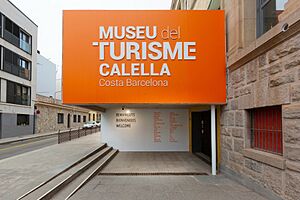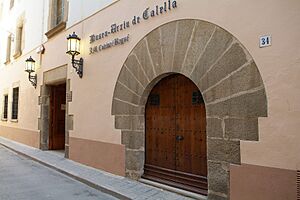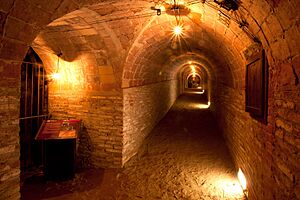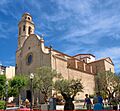Calella facts for kids
Quick facts for kids
Calella
|
||
|---|---|---|
|
Municipality
|
||
 |
||
|
||
| Country | ||
| Community | ||
| Province | Barcelona | |
| Comarca | Maresme | |
| Area | ||
| • Total | 8.0 km2 (3.1 sq mi) | |
| Elevation | 5 m (16 ft) | |
| Population
(2018)
|
||
| • Total | 18,728 | |
| • Density | 2,341/km2 (6,060/sq mi) | |
| Demonym(s) | Calellenc, calellenca | |
Calella (pronounced ka-LEH-lya) is a town in the Maresme region of Spain. It's about 50 km from Barcelona and Girona. The town is also close to the Montnegre-Corredor Natural Park. Calella has a warm Mediterranean climate. It is famous for its beautiful beaches, which stretch for about 3 km.
You can find many natural spots here. These include Dalmau Park, the Manuel Puigvert promenade, and the Garbí promenade. The Calella Lighthouse and The Turrets are also popular landmarks.
Contents
Discovering Calella's Past
How Calella Began
Around 2,000 years ago, the Romans built farms called villas along the coast. These farms grew crops like wheat, oil, and wine. In Calella, parts of a Roman villa have been found near the hospital. It dates back to the time of Jesus.
Calella has a history that goes back about 700 years. In the 11th century, a small group of farmhouses existed in the Capaspre area. This settlement had a defense tower and two small chapels.
The name Calella first appeared in documents in the early 12th century. People started building fishing houses near the stream's mouth. In 1327, the Lord of Montpalau Castle gave Calella the right to have a market. This helped the town grow.
By the 15th century, many farming families moved to Calella. The town grew bigger, adding a defense tower and a new chapel.
In 1525, the Pope allowed a church to be built. Construction began three years later. The new church was finished and blessed in 1564. In 1599, new rules helped organize the town council. This council was made up of juries and councillors.
Calella's Growth and Changes
After some difficult times in the 17th century, Calella began to grow again. After a war ended in 1714, the town's population grew a lot. It went from 768 people in 1718 to 2,637 in 1787. During this time, people started building boats.
The late 1700s were a great time for trade with America. This helped industries like textile making grow. By 1790, over 200 looms were making silk and cotton stockings. New streets were added, making Església Street and Jovara Street central to the town.
The 19th and 20th Centuries
Even with wars, textile factories and trade continued to thrive. In 1854, larger boats and fishing vessels were built. The train arrived in Calella in 1861. This led to more growth, with the population reaching 4,316 by 1900. New steam-powered factories helped the town's economy.
The early 1900s were a golden age for Calella's industry. However, the Spanish Civil War stopped this growth. After the 1960s, tourism became very important. The number of visitors grew hugely in the 1960s and 1970s.
From the 1970s to the mid-1990s, Calella was a popular spot for tourists from Central Europe. Many Germans, Dutch, and English visitors came. People even called it Calella dels Alemanys (Calella of the Germans). The town's population would triple in summer! Today, visitors come from all over Europe.
Cool Places to Visit
Historic Buildings and Landmarks
Parish Church of Santa Maria and Sant Nicolau
Calella got permission to have its own church in 1525. Building started in 1539. The church was finished and blessed in 1564.
The front of the church is in the Baroque style. It has a stone altarpiece from the 16th century. You can see the heads of the twelve apostles. Inside a special spot is Saint Nicolau de Bari, one of the church's patron saints.
Sant Quirze and Santa Julita Chapel
This chapel was first called Sant Elm. It was used as a church while the main church was being built. In 1820, the statues of Calella's patron saints, Sant Quirze and Santa Julita, were moved here. This happened after their old chapel collapsed.
Can Salvador de la Plaça
This old house was built in the 14th century. It was one of the first homes in Calella's town center. It has a beautiful Renaissance doorway and decorated windows. There's also a defensive part on the corner. Today, it's the Municipal Library.
The Calella Lighthouse
The Calella Lighthouse is a famous symbol of the town. It was opened in 1859. The lighthouse helped guide ships with its light. Since 2011, it has been home to the Calella Lighthouse Interpretation Center. Here, you can learn about how lighthouses communicate.
The Turrets
These two towers were built in the mid-1800s. They are on top of Capaspre hill. One was for public use, and the other for military. They sent messages using optical signals, like a very old telegraph system.
Works by Architect Jeroni Martorell Terrats
Dalmau Park
This large green park is in the middle of Calella. It was designed in the late 1920s. It's a great place to walk and enjoy nature. You can find places like La Font dels Lleons (Lions' Fountain) here. The park hosts many cultural events. During the Civil War, an Air Raid Shelter was built inside the park to protect people.
Manuel Puigvert Promenade
This beautiful walkway runs along the beach. It's lined with old banana trees and is a symbol of the city. Mayor Manuel Puigvert started the project. It was finished in 1927. The promenade hosts events like the Calella and Alt Maresme Fair and the Ironman race.
Municipal Market
This building was built in 1927. It has a single large hall. There's also a porch on the main side. It's a great example of the Noucentista style of architecture.
Old Municipal Slaughterhouse
This building was also built in 1927, around the same time as the market. It's another example of the Noucentista style.
People of Calella
| 1900 | 1930 | 1950 | 1970 | 1986 | 2020 |
|---|---|---|---|---|---|
| 4,316 | 7,886 | 7,642 | 9,696 | 11,320 | 19,277 |
The number of people in Calella almost triples during the summer holidays!
Calella's Culture
The Story of "La Llopa" (The She-Wolf)
Around 1920, a local man told people he saw a wolf near the stream. Later, he said he saw two more. Farmers and volunteers went to find the animals. They killed one and showed it to the town.
But it turned out these "wolves" were just large dogs from a nearby farm. They went to the slaughterhouse for food. Since then, people from other towns jokingly call Calella residents "Calella, la Llopa!" (Calella, the She-Wolf!).
Festivals and Traditions
Calella loves its festivals!
- L’Aplec de la Sardana: This is a traditional Catalan dance. It happens every first Sunday in June and has been celebrated since 1926.
- Festa Major Petita: A town festival on June 16th, honoring Sant Quirze and Santa Julita.
- Festa Major de la Minerva: Another town festival on September 23rd.
- Calella i l’Alt Maresme Fair: Also on September 23rd. This fair shows off Catalan products and traditions.
- Beer Festival (Oktoberfest): In October, a big tent hosts German and European bands. You can try German food and drinks.
- Carnival Parade of The Alt Maresme: A fun parade with costumes and music.
- European Choral Singing Festival: A festival for singing groups from across Europe.
- Sing for Gold, the world choral cup: A global competition for choirs.
- Festimatge: A festival for film and photography lovers.
- Calella Film Festival: Another festival celebrating movies.
- International Folklore Festival "Alegria": A festival showcasing traditional dances and music from around the world.
- Fira Renaixentista: A Renaissance Fair that takes you back in time.
Museums in Calella
Museum of Tourism
This museum is special because it's one of a kind! It shows the history of tourism in a fun way. You can learn how travel has changed from the first explorers to today. It helps people understand how tourism affects society and the economy.
Museum – Municipal Archive of Calella Maria Codina Bagué
This museum is in a large house built in the 16th and 17th centuries. It collects and shares the history of Calella. You can see exhibits about the town's textile past and old trade routes.
Calella Lighthouse Interpretation Centre
This center opened in 2011. It explains how the lighthouse communicates with its surroundings. You can learn about sea communication, land communication (like the old optical telegraphy used in The Turrets), and how the town communicates with its bells. It uses videos and texts in different languages.
The Air-raid Shelter of Dalmau Park
This shelter was built in 1937 during the Civil War. It protected people from air attacks. It could hold 3,600 people! Today, you can visit it to learn about this important part of Calella's history. It reminds us of the fight for freedom.
Sports
Calella has its own local football team, called CF Calella.
Film and Television
Calella is part of the Catalonia Film Commission. This means the town helps movies and TV shows film here. The Calella Film Office helps productions find locations and get permits. This makes Calella a "Plato City" (a city for filming).
Main film events include:
- Calella Film Festival
- Festimatge
Calella's Economy
Tourism is the main driver of Calella's economy. The town has been a popular tourist spot for a long time. At first, people lived from fishing and farming. Then, the textile industry grew. Now, tourism is the biggest part of the economy.
Calella has sunny beaches and many tourist facilities. It also focuses on sports tourism, family tourism, and cultural tourism. Sports tourism means people visit to play or watch sports. Family tourism means the town is great for families with kids.
Calella is known as the "tourist capital of the Costa del Maresme." About 250,000 tourists visit each year. The town council works hard to attract more sports and cultural events. Calella has been recognized as a Sports Tourism Destination since 2009. In 2014, it became a Family Tourism Destination. This means it has great places to stay, eat, and play for families.
Shopping is also very important. Calella's central streets are a large shopping area. There are over 1000 shops and services. You can find modern stores, traditional shops, and famous brands. This creates a lively economy for the town.
Calella also has a municipal market open from Tuesday to Saturday. There's also a weekly market on Saturdays.
Some people still work in farming, especially growing strawberries.
Healthcare in Calella
- Hospital “Sant Jaume”: This hospital has 147 beds, 4 surgery rooms, and 3 delivery rooms. It also has many consultation rooms and emergency boxes.
- The Basic Health Area of Calella (ABS): This is the main health center for over 18,700 people.
- Creu Groga: A private medical center with 35 medical specialties. It has many doctors and technicians.
- Elderly Day-Centres: Calella has three centers for older people during the day.
- Old Age Homes: There are five homes for elderly residents.
Images for kids
See also
 In Spanish: Calella para niños
In Spanish: Calella para niños


